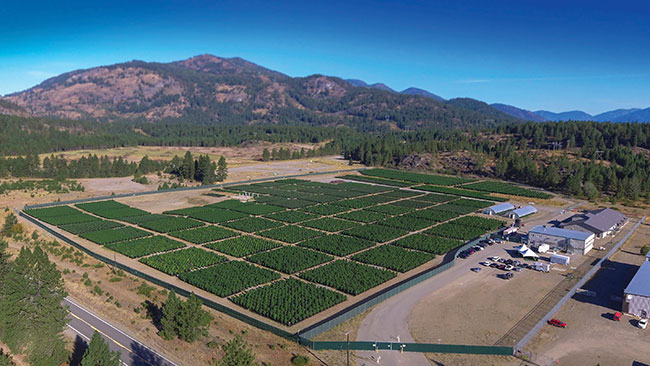
Features
Cultivation
Crafting an outdoor plan
June 25, 2021 By David Brown
 Christina Lake Cannabis operates 32 acres of licensed outdoor cultivation space in B.C. (Photo: Christina Lake Cannabis Corp.)
Christina Lake Cannabis operates 32 acres of licensed outdoor cultivation space in B.C. (Photo: Christina Lake Cannabis Corp.) Outdoor production for a micro cultivator can be one of the most affordable ways to enter the cannabis industry but can also present some of the greatest challenges, when it comes to bringing products to the market.
The lack of an indoor growing facility can mean saving hundreds of thousands or even millions of dollars in construction costs. And relying on the sun for light, instead of powering a facility with lights and extensive heating and cooling systems means a much lower carbon footprint.
Some micro cultivators have been able to secure their licence for less than $20,000, assuming previous availability of land. An indoor micro facility, on the other hand, can often cost upwards of a million dollars.
However, these advantages also come with some serious downsides that any applicant should consider.
Harder to control
Cannabis can be a finicky plant. Sure, it’s “just a weed” and can grow in some incredible circumstances. But if you’re growing a crop for commercial production, you need a certain degree of reliability and replicability, not to mention the need to produce something that can pass all the required federal testing.
Incremental weather, a hail storm at the wrong time, an early frost or an especially wet spell right before harvest can wreak havoc on your cannabis flowers. A modest greenhouse setup can offer some protection from some of these issues, but it can add to the cost of your facility, and can also present new problems to be addressed, like proper air circulation.
Market saturation
The market is flooded with large amounts of dried cannabis, especially from some of the large-scale producers. Even if your outdoor crop is unique, convincing buyers and ultimately, consumers of this will be a challenge and requires a considerable amount of pre-planning. Get a good understanding of current and future market factors before diving in.
Outdoor genetics
Finding the right cultivator that can produce a high-quality product in Canada and will have buyers in the provincial market can be a challenge. Currently, many provinces still balk at cannabis much under 20 per cent THC, for example, and many outdoor crops in Canada are currently finding that their harvests are falling short of this threshold. This can mean either not finding a buyer at all, or being forced to take a much lower price than the grower may have planned on, sometimes well under $1 a gram wholesale.
Taking the time to find the right cultivar or variety that works for your specific location can be a matter of trial and error over several years. Planning for that beforehand can prepare you for some of those realities.
Consumer perception
Despite some interest in a more environmentally friendly cannabis product, many consumers in Canada, right or wrong, have a perception of outdoor as being of a lower quality and potency than indoor. Even if you are knocking out some amazing outdoor product that is well over the 20 per cent THC threshold, and have passed all your relevant microbial testing, etc, you may still find yourself dealing with consumer (and therefore provincial buyer) biases that believe it’s inferior to indoor. This can arguably be combatted through some savvy marketing, but this requires a lot of pre-planning and coordination with retailers as well as some luck.
Site selection
This can partly tie into the issues with weather, but where your outdoor farm is located and the choices you have in site selection can be a real factor in the success of your crop. Whereas indoor production will allow total control over the amount of light your plants receive, the amount of sunlight your outdoor plants receive can be limited by numerous environmental features. If a grower is growing in a location they are used to, they may have taken these issues into consideration, but a new farmer in a new location may be surprised to discover some of these nuances in the first few years that can have a big impact on crop quality and yield.
Another issue can be the type of soil on your site, depending on your growing method. While most growers would recommend growing in raised beds or even pots, some may choose to grow directly in the ground. Taking the time to get all the necessary soil testing done beforehand can save you a lot of heartache later on. If your land isn’t well-drained, for example, or has pesticides in it from previous crops that could contaminate your cannabis.
Know thy enemy
None of this is to necessarily discourage anyone from getting an outdoor cultivation licence, micro or otherwise. The fact that costs for an outdoor producer are so low can more than make up for many of these shortcomings, especially if these are factors considered as part of a plan and mitigated against. As many growers are discovering, the legal cannabis industry is not just as simple as growing a crop, sticking it in a bag and selling it. Understanding the challenges of the market, both in terms of the layers of provincial and federal regulations, as well as consumer perceptions, will help ensure that you’ll be better prepared for these known issues with outdoor cultivation, as well as the many unknowns often lurking around the corner.
David Brown is the founder of StratCann, a cannabis industry publication with a special focus on micros and nurseries. Prior to StratCann, David was a senior policy advisor to Health Canada’s cannabis branch from 2018 to 2020.
Print this page